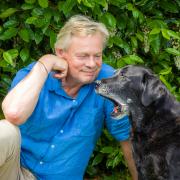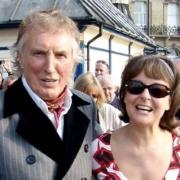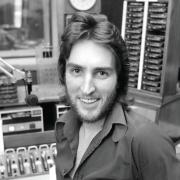As the man behind the controversial Gaia theory James Lovelock is often described as an iconoclast. Philip Howse went to meet the gentle maverick at his Dorset home and talk about his discoveries

I’m sitting on the cliff top at Portland Bill, below Susan, my wife, is lying on the beach several hundred yards away. My dog knows exactly where she is, pointing her nose on a direct compass bearing towards her, she whines. As Susan comes up the winding path hidden from sight, the dog slowly turns her head in a 90 degree arc: she can pick up minute traces of scent in the air - perhaps just a few molecules. We humans can pick up such traces only with the aid of an invention called the gas-liquid chromatograph or GLC, an immensely powerful technique used in every chemistry laboratory in the world (and now in most airports) for identifying trace quantities of pollutants, toxins, carcinogens, drugs, animal and plant odours and secretions: any kind of volatile compound. Without it the search for life on other planets would not be possible.
As I turn and look across Lyme Bay I can just make out a cottage perched on the distant edge of Chesil Beach. This is the home of James Lovelock CH CBE FRS the man who played a key role in the development of GLC, but who is more familiar to millions for his seminal Gaia theory which treats the Earth as a living system. A frequent visitor to the county, James and his wife Sandy chose to move from their Devon home to Dorset several years ago after completing the whole 630 miles of the South Coast Path in 1999. An achievement of which he is justifiably proud - he was then aged 80.
James, who was born in 1919, started his career as a chemist, and during World War Two became involved in medical research at the National Institute for Medical Research in London. At one stage this involved the developing science of cryogenics (study of very low temperature effects). Hamsters were found to be unusually resistant to cold, which he traced to the qualities of the fatty acids in their skin. At that time, the chemist, Archer J. P. Martin, in the same Institute was developing the gas-liquid chromatograph, capable of detecting those compounds, for which he was awarded the Nobel Prize in 1952. Initially, however, Martin did not have a detector in his GLC capable of identifying some of the more reactive and usually toxic compounds that circulate in the environment. James made it his mission to find one. His resulting invention changed his life - in fact all our lives. Most scientists would have stopped at that point published the results and gone on to become a leading specialist in the field, but James was more interested in the problems facing humanity in general.
James Lovelock is no ordinary researcher: he has been listed by Biography Online as one of the seven greatest thinkers of the 20th and 21st centuries. This great thinker next turned his attention to the way in which the earth seemed able to repair the injuries that mankind does to it in a way analogous to that in which a living organism fights injury and disease. He noted, for example, that toxic sulphide gasses released by mining were absorbed by the oceans before they became a serious threat. This was the basis of his Gaia hypothesis (now dignified by scientists as a theory). “I couldn’t think of a suitable name for my hypothesis, but William Golding (author of Lord of the Flies) suggested the name Gaia the ancient Greek mother goddess who gave birth to the Earth.”
James acquired a statue of Gaia, now displayed in his Dorset garden, at the sale of a country house many years before the goddess, serendipitously, became the figurehead of his theory.
To date Lovelock has filed 50 patents in all, some of his inventions contributing to the creation of the microwave oven. He was paid sufficient by the company that chose to exploit his discoveries to be able to set up his own laboratory at home and work independently in Devon. This in turn gave him the opportunity to study atmospheric pollutants that are involved in global warming by taking a long sea voyage with his home-made invention. “My application for a research grant was turned down by the university chemists asked to referee it, although the Natural Environment Research Council itself was keen to fund it,” he explains. “In the end, in 1971, they offered me a free passage on their research vessel RRS Shackleton, retracing the route to the Antarctic that Charles Darwin took on HMS Beagle in the 1830s.”
Each day of the voyage, James took readings of pollutant compounds in the atmosphere, finding their concentration peaked as he went southwards. He soon realised that the north east trade winds were bringing them into the Atlantic from the major European cities. From this he was able to identify high levels of CFCs, products then used in aerosol cans and refrigerators, which are powerful greenhouse gases. These were destroying the ozone layer and leading to global warming and thereby permitting harmful ultraviolet light to enter the atmosphere. His discovery set alarm bells ringing and saved the planet from racing to destruction, but when his findings were investigated further by two American scientists it was they who got the Nobel Prize not James Lovelock.
When I visited James at his coastal home I asked him about his photographs of Dorset, a county he has known for a long time. He startled me by saying “I have one of Studland bay in flames.” He adds: “During the last war Winston Churchill had the bright idea that a Nazi invasion could be stopped if the sea could be set on fire. I said it would never work - you would need immense quantities of oil, and sure enough a wooden vessel was able to sail straight through the blaze without any harm, but they insisted on going ahead.”
Despite his controversial ideas, James usually turns out to have been right. Famously, working for NASA, he maintained that they would not find life on Mars, but that didn’t stop them from spending millions of dollars just to check. “One thing that being a scientist has taught me is that you can never be certain about anything. You never know the truth. You can only approach it and hope to get a bit nearer to it each time. You iterate towards the truth. You don’t know it.”
His Gaia hypothesis was treated savagely by many leading biologists because it did not fit well with evolutionary theory. “Critics can be very cruel” he says ruefully. “Although, I was once invited to give a talk at Oxford and met Bill Hamilton.” Hamilton is regarded by many as the greatest evolutionary biologist of the 20th century. “He said ‘I’m afraid I haven’t read any of your books because my students say they’re rubbish’. After listening to me, Bill read my books and became one of my greatest supporters.”
As time goes on, more previous critics have come round to accepting James’ views, evidenced by a special exhibition currently running at the Science Museum on his life and work called Unlocking Lovelock: Scientist, Inventor, Maverick. He is unafraid of stepping into the arena with controversial views, convinced that by making use of nuclear energy we can manage our resources and ways of living better to ensure the survival of future generations. Wind farms however are a pet hate which he insists are highly inefficient and which he has watched grow and despoil the landscape around his former home in rural Devon. “We rushed into renewable energy without any thought. The schemes are largely hopelessly inefficient and unpleasant. I personally can’t stand windmills at any price. ”
I put it to him that he must gain some satisfaction from the recent news that the ozone layer is thickening again. “I can’t take any credit for that,” he shrugs. “I just made the discovery a long time ago in 1973.”
“Let’s make hay while it lasts,” he once wrote, partly tongue in cheek. Lovelock is not suggesting that we all to rush down to the local tavern to celebrate, but he is asking for the human race to wake up to its responsibilities for the planet.
In his latest book A Rough Ride to the Future he predicts that we can shelter from what he calls the Revenge of Gaia, only by living in closed communities, like ants and termites, in man-made environments. “Back to Huxley’s Brave New World?” I suggest. “Yes,” he says. “Only worse than that.”
At 95 James Lovelock could easily be thought 30 years younger. He has retained his wit, his ability to discuss anything from pop stars to celestial ones, and his creativity is undiminished: he published his seventh book in April this year.
To what does he attribute his dynamism and longevity? “I hardly eat anything - never have done,” he tells me. It’s clear to me, however, that - apart from the fierce curiosity that energises great minds - walking the South West Coast Path with his wife Sandy (he walks a few miles every day), watching the changing moods of the sea at the bottom of his garden and the sunsets over Golden Cap may have something to do with it too. And there are no wind-farms in sight (yet).
What is the Gaia theory?
Also known as the Gaia hypothesis or Gaia principle, it asserts that living organisms and their inorganic surroundings have evolved together as a single living system. Lovelock believes that this “Gaian system” self-regulates global temperature, atmospheric content, ocean salinity, and other factors in an “automatic” manner. The Earth appears to keep conditions on our planet just right for life to persist.
Unlocking Lovelock: Scientist, Inventor, Maverick
Featuring previously unseen materials acquired by the Science Museum in 2012, this exhibition gives a unique insight into Lovelock’s creative mind, personality and unconventional ideas. It includes Lovelock’s laboratory notebooks, drafts of his papers and equipment from the laboratory in his back garden, where some of his most important work was done. You can also see the gas chromatography equipment that journeyed to the Antarctic and back and proved crucial to scientists’ current understanding of global atmospheric pollution. The exhibition runs at the Science Museum in South Kensington until 9 April 2015. More details call 020 7942 4000 or visit sciencemuseum.org.uk. With thanks to the Science Museum for allowing us to use images from their exhibition in this article.
--------------------------------------------------
Read on
• Brad Pitt’s co-star from ‘Fury’ at the Tank Museum• AFC Bournemouth legend Steve Fletcher on the honour of receiving the Sir Tom Finney Award• Best places for international cuisine in Dorset



























